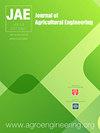两种不同的人工神经网络模型在预测土壤渗透阻力方面的比较
IF 2.5
4区 农林科学
Q2 AGRICULTURAL ENGINEERING
引用次数: 0
摘要
随时间变化的非线性土壤-植物系统包含许多未知因素,这些因素可以通过分析方法进行量化。人工神经网络(ANN)是一种广泛使用的数学计算、建模和预测方法,它能根据已知变量值估算出其他变量的未知值。本文旨在模拟土壤湿度、容重、孔隙比、深度和渗透阻力之间的关系,并借助人工神经网络估算土壤渗透阻力。为此,在 MATLAB 中开发了广义回归神经网络(GRNN)和径向基函数(RBF)模型,并对其进行了比较,以估算土壤渗透阻力值。从试验场收集了 153 个样本数据集。从这 153 个数据中,选择了 102 个数据(33%)用于训练,其余 51 个数据(67%)用于测试。估算过程使用随机选择的测试和训练数据进行了 10 次重复。平均平方误差 (MSE)、均方根误差 (RMSE) 和平均绝对误差 (MAE) 被用来评估所开发的 ANN 方法的估计精度。根据 MSE、RMSE、MAE 和标准偏差 (SD),统计结果表明,在预测土壤渗透阻力成功率方面,GRNN 模型的结果优于 RBF 模型。本文章由计算机程序翻译,如有差异,请以英文原文为准。
Comparison of two different artificial neural network models for prediction of soil penetration resistance
A time-varying, nonlinear soil-plant system contains many unknown elements that can be quantified based on analytical methodologies. Artificial Neural Networks (ANNs) are a widely used mathematical computing, modelling, and predicting method that estimates unknown values of variables from known values of others. This paper aims to simulate relationship between soil moisture, bulk density, porosity ratio, depth, and penetration resistance and to estimate soil penetration resistance with the help of ANNs. For this aim, the Generalized Regression Neural network (GRNN) and Radial Basis Function (RBF) models were developed and compared for the estimation of soil penetration resistance values in MATLAB. A dataset of 153 samples was collected from experimental field. From the 153 data, 102 data (33%) were selected for training and the remaining 51 data (67%) were used for testing. The estimation process was implemented 10 replications using randomly selected testing and training data. Mean Squared Error (MSE), Root Mean Square Error (RMSE), and Mean Absolute Error (MAE) were used to evaluate estimation accuracy on the developed ANN methods. Based on MSE, RMSE, MAE and Standard Deviation (SD), statistical results showed that the GRNN modelling presented better results than the RBF model in predicting soil penetration resistance success.
求助全文
通过发布文献求助,成功后即可免费获取论文全文。
去求助
来源期刊

Journal of Agricultural Engineering
AGRICULTURAL ENGINEERING-
CiteScore
2.30
自引率
5.60%
发文量
40
审稿时长
10 weeks
期刊介绍:
The Journal of Agricultural Engineering (JAE) is the official journal of the Italian Society of Agricultural Engineering supported by University of Bologna, Italy. The subject matter covers a complete and interdisciplinary range of research in engineering for agriculture and biosystems.
 求助内容:
求助内容: 应助结果提醒方式:
应助结果提醒方式:


